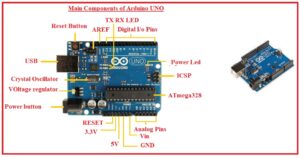Hello readers welcome to new tutorial. Here we will discuss Main Components of Arduino UNO. There are different types of Arduino used such as Lilypad, Arduino Mini, and Arduino Mega. Arduino UNO comes with different features.
This board is employed in different projects and modules that are needed. Here we will discuss the different pins and components of this Arduino with detail. So let get started arduino uno parts,
Main Components of Arduino UNO
- Different arduino uno components are discussed here.

Microcontroller
- It is main part of Arduino that is ATMEGA328.
- It comes with digital pins of fourteen. Six analog input pinouts.
- DC current for this module is forty milliamperes.
GPIO Pinout
- Pins lies on the upper and lower portion called GPIO or general-purpose pinouts. These pins helps to make a connection with other exterior modules.
Digital Pins
- These pinout has features to give power five volts high and zero volts low to other devices connected with Arduino. Pins numbers from zero to thirteen are digital pins
Analog Pins
- These pins are nominated as Ao to A5 and used to sense voltage values of zero and five volts.
Power Pins
- These pins has the ability to power five volts to other exterior devices link to this board.
SDA and SCL Pins
- These pins are used as I2C communication protocol.
TX and Rx
- These two pins used for UART communication.
PWM Pins
- These are used as pulse-width modulation pins.
Reset Button
- This button is used for restarting the Arduino modules.
Crystal Oscillator
- This module helps Arduino to make an overview of the time and creates pulse width modulation aslo used for serial communication
Input Jack
- Through this module power of five volts can be given to Arduino through USB.
Voltage Regulator
- This point is used to reduce the voltage value 12 to seven according to module demand.
USB Connector
- Through this point, programs are given to the board through use of a USB module. Serial data produced through the board is sent to the computer and can be seen on a computer screen
Arduino uno parts
Arduino board components aer listed here
- Analog Reference pin
- Digital Ground pinout
- Digital Pins 2 to 13
- Digital Pins 0 to1
- Analog In Pins 0 to 5
- Reset Button
- In-circuit Serial Programmer
- USB
- Power and Ground Pinout
- External Power Source
- Toggles External Power supply and USB
Microcontrollers
ATmega328P is mostly used on different types of Arduino boards. That comes with these pins
- It has 14 digital input and output pins
- Six analog input pins
- static ram of 2 KB
- At each input and output pins there is forty milimper current given
- it comes with tirthy two kb flash
- One KB EEPROM
That is all about the Main Components arduino uno parts,. .I have explained all parts of this board with detail if you have any further query ask in the comments. Thanks for reading.






